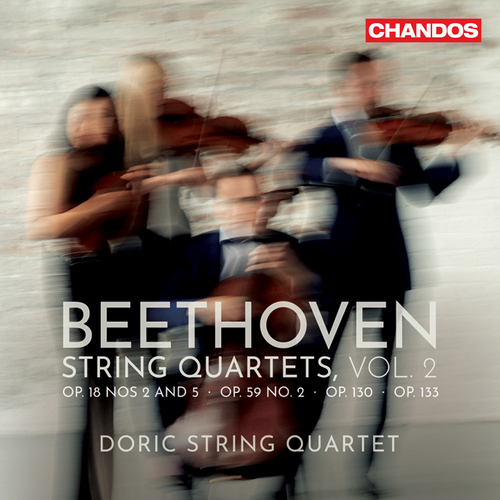BEETHOVEN String Quartets Vol 2
View record and artist detailsRecord and Artist Details
Genre:
Chamber
Label: Chandos
Magazine Review Date: 11/2024
Media Format: CD or Download
Media Runtime: 157
Mastering:
DDD
Catalogue Number: CHAN20300

Tracks:
| Composition | Artist Credit |
|---|---|
| String Quartet No. 2 |
Ludwig van Beethoven, Composer
Doric String Quartet |
| String Quartet No. 5 |
Ludwig van Beethoven, Composer
Doric String Quartet |
| String Quartet No. 8, 'Rasumovsky' |
Ludwig van Beethoven, Composer
Doric String Quartet |
| String Quartet No. 13 |
Ludwig van Beethoven, Composer
Doric String Quartet |
| Grosse Fuge |
Ludwig van Beethoven, Composer
Doric String Quartet |
Author: David Gutman
Here is the second release in a major studio cycle launched earlier in this, the Doric’s 25th year and intended to conclude in time for the 200th anniversary of Beethoven’s death. Significant competition comes from Quatuor Ébène, who lately celebrated their own 20-year career milestone coinciding with the composer’s 250th birthday. While both groups come across as ‘youthful’, in-the-moment iconoclasts determined to avoid steady-as-she-goes routine, it is the Doric who stray furthest from older interpretative and conceptual norms. The Ébène intégrale was recorded (mostly) live in more or less glitzy locations worldwide (Erato, 11/20). The Doric, at home in Suffolk’s Potton Hall, adopt a more intimate strategy. So far, each double-album-length instalment has comprised quartets early, middle and late, the choice of scores and the manner of their realisation throwing fresh light on Beethoven’s stylistic reach and the meaning of his legacy to a contemporary audience.
Typically, the two Op 18 quartets within the present volume are not bunched together. Pairing Op 18 No 5 and the E minor ‘Rasumovsky’ on disc 2 unites two of the very few quartets in which the composer asks for both main sections of the first movement to be repeated. This is a rare device for Beethoven and the injunction is ignored by practitioners such as the Ébène. In Op 130 the rival teams include the first-movement repeat and restore the Grosse Fuge to its rightful place as the quartet’s finale. Then again, only the Doric give us the option of substituting Beethoven’s alternative (or appending it as an encore).
The risk is that listeners accustomed to more in the way of full-throatedness and continuous cantabile will find the results at once underpowered and overwrought. The group bring the scratch and scurry of ‘historically informed’ Haydn to Op 18 No 2, rushing fences for comic effect and reintroducing vibrato chiefly to animate the Adagio’s singing line. The more Mozartian/Schubertian tone of Op 18 No 5 means less resort to a kind of skittering glassiness. Its Minuet and Trio takes in some offbeat characterisation nonetheless: you may or may not relish the intimations of Shostakovich. In both pieces the players employ specially made original-style bows by Luis Emilio Rodríguez Carrington.
Fuller sonorities are permitted to colour the later scores yet vibrato is applied with a restraint that may worry older hands and the deployment of portamento is nothing if not idiosyncratic. Surfaces remain volatile, the music looking forward and back. Rounding out disc 1 is a rousing account of Op 130, a work the group have played many times over the years with different line-ups but the same unswerving dedication. Posing questions no one ensemble can answer, Beethoven often seems to be testing how far it is possible to articulate an underlying form while simultaneously offering a sceptical critique. In truth the slithery shenanigans of the Alla danza tedesca made me feel a little seasick, and while the Grosse Fuge makes a big impact, the crunch isn’t always merely harmonic. Physical aspects of the writing sometimes play a new role. Leavening all that edginess and thrust, certain passages are lighter and more carefree than usual, these remarkable players always ready to surprise. The preceding Cavatina will either strike you as honest and unexaggerated or disappoint with its relatively swift pacing and avoidance of soupier anguish. The wispy geklemmt passage is a long way from the choked emotional spasm posited by the Ébène in a public arena.
No one sympathetic to 21st-century Beethoven is likely to be disappointed by the present offering. The sound – set closer to the listener than one expects from this source, which means that some breathing is caught – is certainly faithful, lean and unprettified. That extreme pianissimos give the impression of receding into the distance is probably a tribute to the mesmerising playing of first violinist Alex Redington. Recommended, although it may not be to all tastes. The weighty accompanying annotations are by veteran Beethoven scholar William Drabkin.
Discover the world's largest classical music catalogue with Presto Music.

Gramophone Digital Club
- Digital Edition
- Digital Archive
- Reviews Database
- Full website access
From £8.75 / month
Subscribe
Gramophone Full Club
- Print Edition
- Digital Edition
- Digital Archive
- Reviews Database
- Full website access
From £11.00 / month
Subscribe
If you are a library, university or other organisation that would be interested in an institutional subscription to Gramophone please click here for further information.




